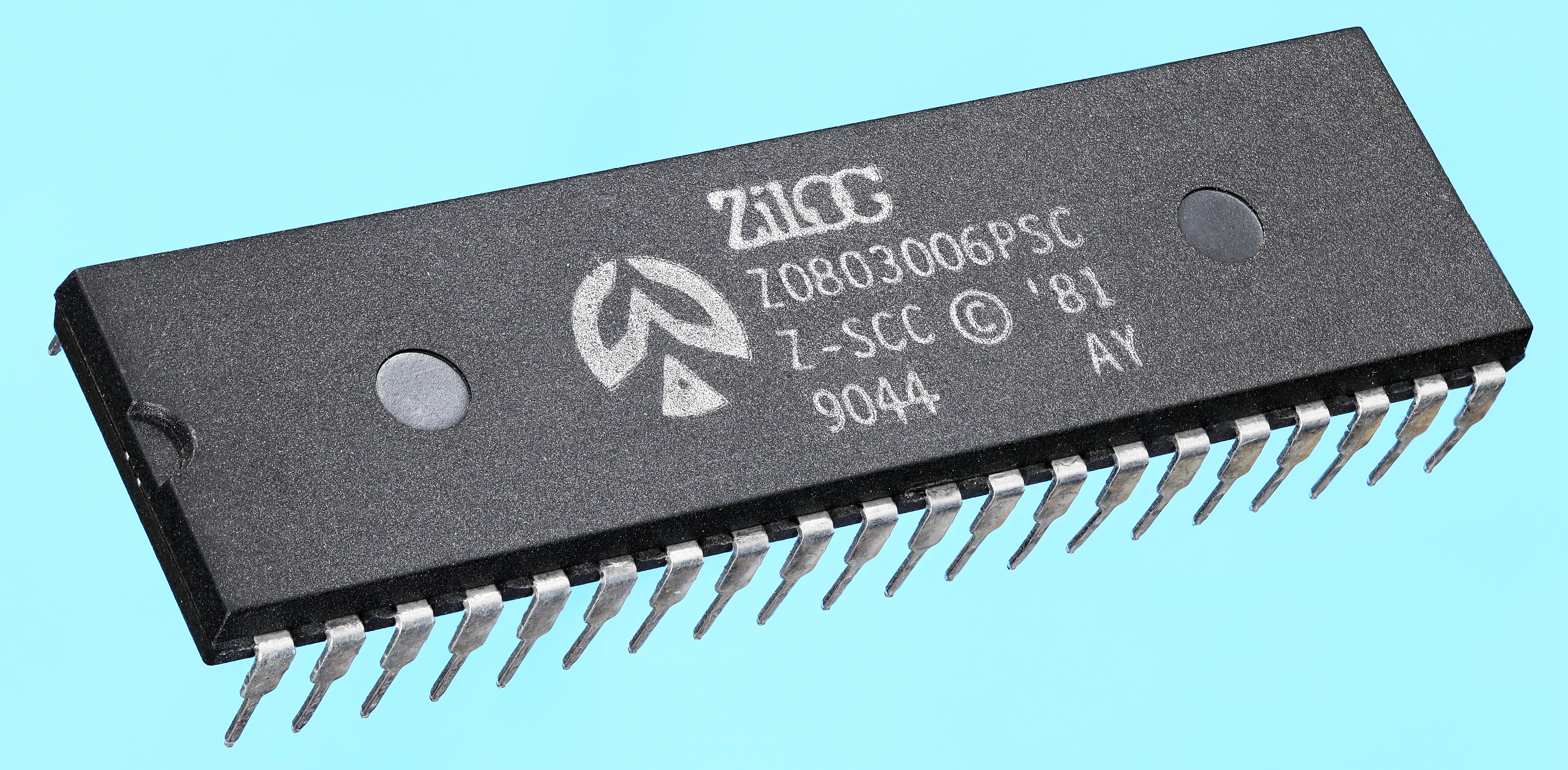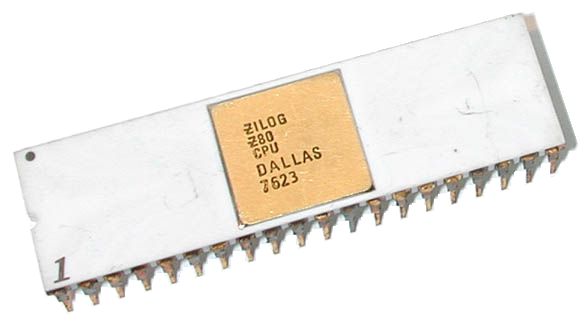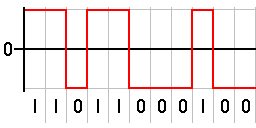|
Zilog SCC
The SCC, short for Serial Communication Controller, is a family of serial port driver integrated circuits made by Zilog. The primary members of the family are the Z8030/Z8530, and the Z85233. Developed from the earlier Zilog SIO devices (Z8443), the SCC added a number of serial-to-parallel modes that allowed internal implementation of a variety of data link layer protocols like Bisync, HDLC and SDLC. The SCC could be set up as a conventional RS-232 port for driving legacy systems, or alternately as a RS-422 port for much higher performance, up to 10 Mbit/s. Implementation details generally limited performance to 5 Mbit/s or less. One of the most famous users of the SCC was the Apple Macintosh computer line, which used the Z8530 to implement two serial ports on the back of the early designs, labeled "modem" and "printer". Description Traditional serial communications are normally implemented using a device known as a UART, which translates data from the computer bus ... [...More Info...] [...Related Items...] OR: [Wikipedia] [Google] [Baidu] |
ZILOG Z0803006 SCC
Zilog, Inc. is an American manufacturer of microprocessors and 8-bit computing, 8-bit and 16-bit computing, 16-bit microcontrollers. It is also a supplier of application-specific embedded system-on-chip (SoC) products. Its most famous product is the Zilog Z80, Z80 series of 8-bit microprocessors that were compatible with the Intel 8080 but significantly cheaper. The Z80 was widely used during the 1980s in many popular home computers such as the TRS-80, MSX, Amstrad CPC and the ZX Spectrum, as well as arcade games such as ''Pac-Man''. The company also made 16- and 32-bit processors, but these did not see widespread use. From the 1990s, the company focused primarily on the microcontroller market. The name (pronunciation varies) is an acronym of ''Z integrated logic'', also thought of as "Z for the last word of Integrated Logic". In the oral history interview video which Federico Faggin (co-founder of Zilog) recorded for the Computer History Museum, he pronounced Zilog with a long ... [...More Info...] [...Related Items...] OR: [Wikipedia] [Google] [Baidu] |
BiSync
Binary Synchronous Communication (BSC or Bisync) is an IBM character-oriented, half-duplex link protocol, announced in 1967 after the introduction of System/360. It replaced the synchronous transmit-receive (STR) protocol used with second generation computers. The intent was that common link management rules could be used with three different character encodings for messages. Six-bit Transcode looked backwards to older systems; USASCII with 128 characters and EBCDIC with 256 characters looked forward. Transcode disappeared very quickly but the EBCDIC and USASCII dialects of Bisync continued in use. At one time Bisync was the most widely used communications protocol and is still in limited use in 2013. Framing Bisync differs from protocols that succeeded it in the complexity of message framing. Later protocols use a single framing scheme for all messages sent by the protocol. HDLC, Digital Data Communications Message Protocol (DDCMP), Point-to-Point Protocol (PPP), etc ... [...More Info...] [...Related Items...] OR: [Wikipedia] [Google] [Baidu] |
Zilog Z8000
The Z8000 ("''zee-'' or ''zed-eight-thousand''") is a 16-bit microprocessor introduced by Zilog in early 1979. The architecture was designed by Bernard Peuto while the logic and physical implementation was done by Masatoshi Shima, assisted by a small group of people. In contrast to most designs of the era, the Z8000 did not use microcode which allowed it to be implemented in only 17,500 transistors. The Z8000 was not Z80-compatible, although it featured many of the well-received design notes that made the Z80 popular. Among these was the ability for its registers to be combined and used as a single larger register - while the Z80 allowed two 8-bit registers to be used as a single 16-bit register, the Z8000 expanded this by allowing two 16-bit registers to operate as a 32-bit register, or four to operate as a 64-bit register. These combined registers were particularly useful for mathematical operations. Although it was an attractive design for its era, and saw some use in the e ... [...More Info...] [...Related Items...] OR: [Wikipedia] [Google] [Baidu] |
Chip Carrier
In electronics, a chip carrier is one of several kinds of surface-mount technology packages for integrated circuits (commonly called "chips"). Connections are made on all four edges of a square package; compared to the internal cavity for mounting the integrated circuit, the package overall size is large.Kenneth Jackson, Wolfgang Schroter, (ed), ''Handbook of Semiconductor Technology Volume 2'',Wiley VCH, 2000, ,page 627 Types Chip carriers may have either J-shaped metal leads for connections by solder or by a socket, or may be lead-less with metal pads for connections. If the leads extend beyond the package, the preferred description is "flat pack". Chip carriers can be smaller than dual in-line packages and since they use all four edges of the package they can have a larger pin count. Chip carriers may be made of ceramic or plastic. Some forms of chip carrier package are standardized in dimensions and registered with trade industry associations such as JEDEC. Other forms ... [...More Info...] [...Related Items...] OR: [Wikipedia] [Google] [Baidu] |
Dual In-line Package
In microelectronics, a dual in-line package (DIP or DIL), is an electronic component package with a rectangular housing and two parallel rows of electrical connecting pins. The package may be through-hole mounted to a printed circuit board (PCB) or inserted in a socket. The dual-inline format was invented by Don Forbes, Rex Rice and Bryant Rogers at Fairchild R&D in 1964, when the restricted number of leads available on circular transistor-style packages became a limitation in the use of integrated circuits. Increasingly complex circuits required more signal and power supply leads (as observed in Rent's rule); eventually microprocessors and similar complex devices required more leads than could be put on a DIP package, leading to development of higher-density chip carriers. Furthermore, square and rectangular packages made it easier to route printed-circuit traces beneath the packages. A DIP is usually referred to as a DIP''n'', where ''n'' is the total number of pins. Fo ... [...More Info...] [...Related Items...] OR: [Wikipedia] [Google] [Baidu] |
Macintosh Plus
The Macintosh Plus computer is the third model in the Macintosh line, introduced on January 16, 1986, two years after the original Macintosh and a little more than a year after the Macintosh 512K, with a price tag of US$2,599. As an evolutionary improvement over the 512K, it shipped with 1 MB of RAM standard, expandable to 4 MB, and an external SCSI peripheral bus, among smaller improvements. Originally, the computer's case was the same beige color as the original Macintosh, Pantone 453; however, in 1987, the case color was changed to the long-lived, warm gray "Platinum" color. It is the earliest Macintosh model able to run System Software 5, System 6, and System 7. Overview Bruce Webster of ''BYTE'' reported a rumor in December 1985: "Supposedly, Apple will be releasing a Big Mac by the time this column sees print: said Mac will reportedly come with 1 megabyte of RAM ... the new 128K-byte ROM ... and a double-sided (800K bytes) disk drive, all in the standard Mac ... [...More Info...] [...Related Items...] OR: [Wikipedia] [Google] [Baidu] |
NMOS Logic
N-type metal-oxide-semiconductor logic uses n-type (-) MOSFETs (metal-oxide-semiconductor field-effect transistors) to implement logic gates and other digital circuits. These nMOS transistors operate by creating an inversion layer in a p-type transistor body. This inversion layer, called the n-channel, can conduct electrons between n-type "source" and "drain" terminals. The n-channel is created by applying voltage to the third terminal, called the gate. Like other MOSFETs, nMOS transistors have four modes of operation: cut-off (or subthreshold), triode, saturation (sometimes called active), and velocity saturation. For many years, NMOS circuits were much faster than comparable PMOS and CMOS circuits, which had to use much slower p-channel transistors. It was also easier to manufacture NMOS than CMOS, as the latter has to implement p-channel transistors in special n-wells on the p-substrate. The major drawback with NMOS (and most other logic families) is that a DC current ... [...More Info...] [...Related Items...] OR: [Wikipedia] [Google] [Baidu] |
Manchester Encoding
In telecommunication and data storage, Manchester code (also known as phase encoding, or PE) is a line code in which the encoding of each data bit is either low then high, or high then low, for equal time. It is a self-clocking signal with no DC component. Consequently, electrical connections using a Manchester code are easily galvanically isolated. Manchester code derives its name from its development at the University of Manchester, where the coding was used for storing data on the magnetic drums of the Manchester Mark 1 computer. Manchester code was widely used for magnetic recording on 1600 bpi computer tapes before the introduction of 6250 bpi tapes which used the more efficient group-coded recording. Manchester code was used in early Ethernet physical layer standards and is still used in consumer IR protocols, RFID and near-field communication. Features Manchester coding is a special case of binary phase-shift keying (BPSK), where the data controls the phase ... [...More Info...] [...Related Items...] OR: [Wikipedia] [Google] [Baidu] |
Non-return-to-zero
In telecommunication, a non-return-to-zero (NRZ) line code is a binary code in which ones are represented by one significant condition, usually a positive voltage, while zeros are represented by some other significant condition, usually a negative voltage, with no other neutral or rest condition. For a given data signaling rate, i.e., bit rate, the NRZ code requires only half the baseband bandwidth required by the Manchester code (the passband bandwidth is the same). The pulses in NRZ have more energy than a return-to-zero (RZ) code, which also has an additional rest state beside the conditions for ones and zeros. When used to represent data in an asynchronous communication scheme, the absence of a neutral state requires other mechanisms for bit synchronization when a separate clock signal is not available. Since NRZ is not inherently a self-clocking signal, some additional synchronization technique must be used for avoiding bit slips; examples of such techniques are a ... [...More Info...] [...Related Items...] OR: [Wikipedia] [Google] [Baidu] |
Systems Network Architecture
Systems Network Architecture (SNA) is IBM's proprietary networking architecture, created in 1974. It is a complete protocol stack for interconnecting computers and their resources. SNA describes formats and protocols but, in itself, is not a piece of software. The implementation of SNA takes the form of various communications packages, most notably Virtual Telecommunications Access Method (VTAM), the mainframe software package for SNA communications. History SNA was made public as part of IBM's "Advanced Function for Communications" announcement in September, 1974, which included the implementation of the SNA/SDLC (Synchronous Data Link Control) protocols on new communications products: *IBM 3767 communication terminal (printer) *IBM 3770 data communication system They were supported by IBM 3704/3705 communication controllers and their Network Control Program (NCP), and by System/370 and their VTAM and other software such as CICS and IMS. This announcement was followed by ano ... [...More Info...] [...Related Items...] OR: [Wikipedia] [Google] [Baidu] |
Local Area Networking
A local area network (LAN) is a computer network that interconnects computers within a limited area such as a residence, school, laboratory, university campus or office building. By contrast, a wide area network (WAN) not only covers a larger geographic distance, but also generally involves leased telecommunication circuits. Ethernet and Wi-Fi are the two most common technologies in use for local area networks. Historical network technologies include ARCNET, Token Ring and AppleTalk. History The increasing demand and usage of computers in universities and research labs in the late 1960s generated the need to provide high-speed interconnections between computer systems. A 1970 report from the Lawrence Radiation Laboratory detailing the growth of their "Octopus" network gave a good indication of the situation. A number of experimental and early commercial LAN technologies were developed in the 1970s. Cambridge Ring was developed at Cambridge University starting in 1974. Eth ... [...More Info...] [...Related Items...] OR: [Wikipedia] [Google] [Baidu] |





.jpg)